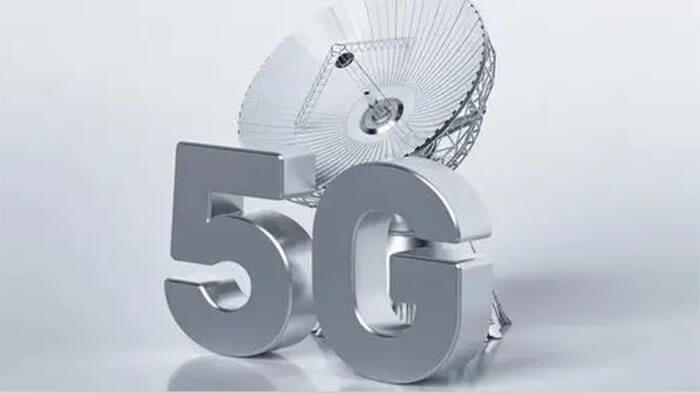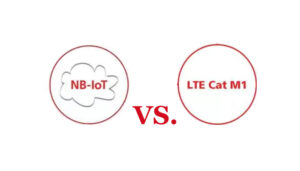Today, we talk about the 5G NR communication technology and its characteristics.
The current communication technology is mainly divided into two types: wired communication and wireless communication. Wired communication uses wired media for conduction, such as copper wire, optical fiber, and so on.
Data transmission in wired media can reach a very high rate, and the current maximum experimental rate of a single fiber can reach 26Tbps. But the bottleneck of mobile communication lies in the wireless communication part. The current mainstream mobile communication standard is LTE, with a theoretical speed of 150Mbps, which is much lower than the wired transmission rate.
Basic principles of 5G NR communication technology
Introducing the basic theoretical formula c=λν (speed of light=wavelength frequency), the frequency of light waves used in optical fibers is between 1014-1020Hz, and the frequency of radio waves is between 106-1010Hz, and lightwave communication is now gradually developing.
Name Symbol Frequency (Hz) Band Wavelength (m) Use
Very low-frequency ELF 3-30 Very long wave 100M-10M
Ultra-low frequency SLF 30-300 Ultra-long wave 10M-1M
Ultra low-frequency ULF 300-3K Extra long wave 1 mega-100,000
Very low-frequency VLF 3K-30K Very long wave 100,000-10,000 Submarine communication, long-distance, ultra-long-distance communication
Low-frequency LF 30K-300K long wave 10,000-11,000 transoceanic communication, medium-distance communication, underground rock formation communication, long-distance navigation
Intermediate frequency MF 300K-3M medium wave 1,000-1 hundred marine communications, amateur radio communications, mobile communications, mid-range navigation
High-frequency HF 3M-30M Shortwave 100-10 Long-distance shortwave communication, international fixed-point communication, mobile communication
Very high-frequency VHF 30M-300M Ultrashort wave 10-1 Ionospheric scattering, meteor trail communication, artificial ionospheric communication, communication to space vehicles, mobile communication
Ultra high-frequency UHF 300M-3G decimeter wave, microwave 1-1 point Small capacity microwave relay communication, tropospheric scattering communication, medium-capacity microwave communication, mobile communication
Ultra-high frequency SHF 3G-30G centimeter wave 1 minute -1% large-capacity microwave relay communication, mobile communication, satellite communication, international maritime satellite communication
Extremely high-frequency EHF 30G-300G millimeter-wave 1 cm-1 mm communication during re-entry into the atmosphere, waveguide communication
To high-frequency THF 300G-3T silk rice wave 1 milli-1 silk
At present, the band range of mobile communication we use belongs to IF-UHF.
1G mainly includes AMPS, NMT, TACS, and other communication standards.
2G mainly includes GSM, TDMA, CDMA, PDC and iDEN, and other communication standards.
3G mainly includes WCDMA, CDMA2000, TD-SCDMA, WiMAX, and other communication standards.
4G mainly includes LTE, TD-LTE, and FDD-LTE communication standards.
5G mainly has mixed D2D (TDD and FDD) communication standards.
At present, the mainstream LTE technology belongs to UHF and UHF. With the development of communication technology, the frequency of radio waves used is getting higher and higher, and the transmission rate that can be carried is higher, which can be summarized as the following relationship
Higher frequency = higher carrying rate = higher data-carrying capacity
5G currently has two main frequency ranges (not NSA/SA mentioned in networking).
According to the list of 5G NR-supported frequency bands specified by 3GPP, it can be known that up to 100GHz
5G NR FR1 450MHz-6GHz Maximum 100Mhz
5G NR FR2 24.25GHz-52.6GHz Maximum 400MHz
Calculate according to the aforementioned formula:
Therefore, the important technical feature of 5G NR communication technology mentioned in the media, millimeter wave, is derived in this way.
The impact of high-frequency radio waves on the construction of base stations
Why is the millimeter-wave data-carrying capacity not used in the past 1G-4G communications when the data-carrying capacity is so high? The main reason is based on cost factors.
According to physical principles, we can know the characteristics of electromagnetic waves: the higher the frequency, the shorter the wavelength, the closer it is to a straight line, the lower the diffraction ability, and the greater the attenuation.
Typical losses are as follows: free space path loss, diffraction loss, penetration loss, and rain attenuation loss.
The biggest drawback of 5G NR’s use of high-frequency transmission is that the transmission distance and coverage are greatly reduced. In the case of achieving signal coverage in the same area, the number of 5G NR communication technology base stations will far exceed the number of 4G base stations.
In other words, the construction cost of the base station will rise substantially. Traditional low-frequency communication has longer wavelengths and long transmission distances, which can achieve high-power and large-scale coverage and reduce the number of base stations.
Therefore, based on the frequency characteristics of 5G NR communication technology, the base stations to be built in the future will tend to be smaller, smaller in power, and larger in number.
The advantages of 5G NR millimeter wave, the principle of beamforming
If the length of a pair of antennas is equal to half a wavelength, the antenna at this time is in a resonant state, with the smallest characteristic impedance and pure resistance, no reactance, the smallest loss, and the largest radiation.
Therefore, the shorter the wavelength of the electromagnetic wave, the smaller the volume of a single antenna unit required, and more dipole units can be constructed on the flat directional antenna of the same area.
When an antenna is used, the radiation direction of electromagnetic waves propagates in 360 degrees, but an antenna array can realize the single-directional propagation of electromagnetic waves.
The greater the number of antennas, the more concentrated the electromagnetic wave propagation direction. Two or more antennas will transmit signals with a controlled delay or phase shift, thereby creating a directional constructive interference lobe.
In the FDD system, the user terminal provides feedback in the form of a precoding matrix index (PMI); however, in the TD-LTE system, this requirement is canceled due to the reciprocity of the channel.
In the TD-LTE system, the user terminal sends a channel report signal to the base station, and the base station checks the relative phase difference between antennas of the same polarization, so as to estimate the direction of arrival (DoA) of the user terminal.
Although the estimation is performed in the uplink, the base station can still use channel reciprocity to perform transmission tasks in the downlink based on the estimation of the uplink.
According to DoA, the RRU dynamically adjusts the antenna weight (relative amplitude and phase) of each component in the antenna array, directs the beam to the desired user, or directs the zero signal to the direction where no interference is required. This is the basic working principle of beamforming in LTE.
In the 5G NR communication technology system, LTE’s proportional fairness (PF) scheduler is optimized. 5G NR communication technology is based on the CSI-RS beam reporting system for scheduling. If PF is used for allocation, it will not be able to achieve sufficient interaction speed, so the Beam optimization mechanism is introduced.
5G NR communication technology will bring greater access to MIMO (Multiple Input Multiple Output) networks, but in MIMO networks, cellular base stations send and receive radio frequency signals in parallel through more antennas than are usually used on base stations, improving the base station’s data throughput performance.
But these signals can also interfere with each other. Beamforming is an efficient signal processing technology that enables the base station to send target data beams to users, thereby reducing interference and making more effective use of the radio frequency spectrum.
CU-DU separation of 5G NR communication technology
The full name of CU is a Centralized Unit, as the name implies, it is a centralized unit; the full name of DU is Distributed Unit.
The 4G LTE access part structure is the core network-BBU-RRU-antenna feeder, and the base station is directly connected to the core network through the BBU.
In 5G NR communication technology, RRU and antenna feeder are combined into AAU, BBU is split into DU and CU, each base station has one DU, and multiple sites share a common CU for centralized management.
As early as in the 2G and 3G era, the wireless access architecture was similar to 5G NR, and multiple base stations were managed by the same BSC/RNC controller.
Compared with 2G and 3G, the 4G network architecture is a drastic change, which brings low latency and deployment flexibility. The problem is also obvious, mainly due to the inefficiency of information exchange between base stations.
When the BBU is directly connected to the core network, each base station must independently exchange information with surrounding base stations to form a one-to-many network interaction structure. In the case of a large number of base stations, the number of connections will increase exponentially, leading to interference between base stations being difficult to coordinate, and the network is congested or even paralyzed.
2G and 3G networks are different, because with the presence of the omniscient and omnipotent central node of the controller, the information of all base stations is clear at a glance, and overall management of global resources is easier.
Therefore, in the 5G NR era, various functions of the core network have been re-architected, the physical layer processing of the original BBU is transferred to the RRU, and the RRU and the antenna feeder system are combined into an integrated AAU, which combines the original BBU. Split into CU and DU, CU integrates some core network functions and becomes a management node.
The division of CU and DU is based on the real-time requirements of different protocol layers. Put the physical bottom layer in the original BBU to AAU for processing.
The media access control sublayer MAC and radio link control sublayer RLC in the physical layer 2 with high real-time requirements are placed in the DU for processing, and the packet data with low real-time performance is aggregated PDCP (Packet Data Convergence Protocol) and RRC layer (Radio Resource Control) are placed in the CU for processing.
5G NR communication technology core
CU (Station1&2&3&4)
DU DU DU DU
AAU AAU AAU AAU
Station1 Station2 Station3 Station4
5G NR communication technology wireless network architecture
The benefits of the separation of CU and DU are as follows
1. Realize the sharing of base station resources
Since the idle and busy time of each base station is different, the general practice is to configure each base station to the maximum capacity, but in many cases, it cannot be achieved.
Taking the example school with a large population migration scale, the school building has a high volume of business access during the day, and is basically idle at night, while the student dormitory has a high volume of business access at night.
If these two places are designed according to the maximum capacity, it will definitely cause a waste of resources, because the total service access is basically the same.
If the base stations of the teaching building and the dormitory are managed in a unified manner, the DU is deployed in a centralized manner, and the CU is scheduled in a unified manner, the general baseband resources can be saved, not to mention a larger park with more than one base station.
The deployment method of CU and DU is similar to that of 4G C-RAN, but C-RAN has too high requirements for fiber resources and the cost is too high to be realized.
The same is true in 5G NR communication technology. After all, CU and DU are still deployed in the same base station, which can also achieve a certain degree of common resource sharing. It is also another way to achieve C-RAN. It will not be very clear in the short term. The deployment of CU and DU is divided.
In the early stage of construction, the two were mainly based on logical separation, but they still existed in one. For the future of 5G NR communication technology, CU and DU must coexist in the two architectures of co-location and separation.
2. It can better meet the access requirements of different scenarios
5G NR communication technology introduces millimeter waves into practical applications. Due to the characteristics of frequency bands, the number of sites will increase exponentially. It forms a high- and low-frequency mixed network environment with low-frequency sites. If you want to maximize performance in this environment, you must There is a high-performance central control node for the collaborative management of the two.
CU can perform this role, but while the split brings many advantages, the disadvantages are also obvious. The most obvious disadvantage is the increase in delay. For the three main business scenarios, enhanced mobile broadband eMBB, large-connected IoT mMTC, and ultra-high-reliability and ultra-low-latency communication uRLLC have different impacts.
eMBB does not require high latency. As long as the data rate is sufficient, you don’t need to care about latency; mMTC has lower latency requirements and only needs to be able to communicate, but the impact on uRLLC is huge, and it is critical for some parts. Business is not allowed to exist.
Therefore, it is possible to split the construction for different business needs according to the specific situation. eMBB and mMTC can be deployed separately from CU/DU to improve utilization, but for uRLLC, CU/DU combined construction is required.
This year, 5G NR communication technology commercial use mainly supports eMBB services. Currently, 3.5GHz is mostly used internationally. Because the coverage of this frequency band is equivalent to that of 4G, to a large extent, 4G and 5G NR communication technology share computer rooms and base stations in the initial stage, the lowest-cost approach.
It only needs to upgrade the supporting equipment such as the power supply inside the original machine room, put it into the CU/DU integrated 5G base station, and install it in the rack, and then 5G NR communication technology can be quickly activated.
If the CU and DU are separated, a dedicated data center needs to be built, which is too costly. So in the initial stage, CU/DU is only logically divided, in fact, the two are still integrated equipment.
Besides the 5G NR Communication Technology And Characteristics article, you may also be interested in the below articles.
PCB Antenna VS. External Antenna
Ceramic Antenna VS. PCB Antenna, A Comparison Guide
Wifi vs. 5G, is 5G better than Wifi?
Mobile Networks’ Evolution From 1G To 5G




